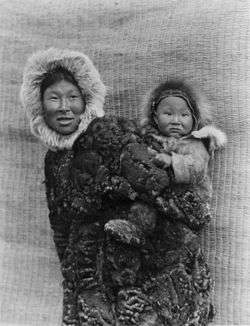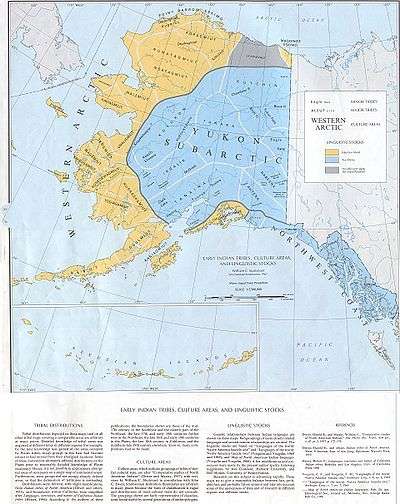Alaska Natives
| Total population | |
|---|---|
| ~106,660 (2006)[1] | |
| Regions with significant populations | |
|
| |
| Languages | |
| English, Russian (historically), Haida, Tsimshianic languages, Eskimo–Aleut languages, Chinook Jargon, Na-Dené languages, others | |
| Religion | |
| Shamanism (largely ex), Christianity (Protestantism, Russian Orthodoxy, Catholic) |
Alaska Natives are indigenous peoples of Alaska, United States and include: Iñupiat, Yupik, Aleut, Eyak, Tlingit, Haida, Tsimshian, and a number of Northern Athabaskan cultures. They are often defined by their language groups. Many Alaska Natives are enrolled in federally recognized Alaska Native tribal entities, who in turn belong to 13 Alaska Native Regional Corporations, who administer land and financial claims.
Ancestors of Alaska Natives migrated into the area thousands of years ago, in at least two different waves. Some are descendants of a third wave of migration in which people settled across the northern part of North America. They never migrated to southern areas. For this reason, genetic studies show they are not closely related to Native Americans in South America.
Throughout the Arctic and the circumpolar north, the ancestors of Alaska Natives established varying indigenous, complex cultures that have succeeded each other over time. They developed sophisticated ways to deal with the challenging climate and environment, and cultures rooted in the place. Historic groups have been defined by their languages, which belong to several major language families. Today, Alaska Natives comprise over 15% of the population of Alaska.[2]
Demographics
The Alaska Natives Commission estimated that there were about 86,000 Alaska Natives living in Alaska in 1990, with another 17,000 who lived outside Alaska.[3] A 2013 study by the Alaska Department of Labor and Workforce Development documented over 120,000 Alaska Native people in Alaska.[4] While the majority of Alaska Natives live in small villages or remote regional hubs such as Nome, Dillingham, and Bethel, the percentage who live in urban areas has been increasing. In 2000, 38% lived in urban areas, compared to 44% in the 2010 census.[4]
Russian colonial period
Arriving from Siberia by ship in the mid-eighteenth century, Russians began to trade with Alaska Natives. New settlements around trading posts were started by Russians, including Russian Orthodox missionaries. These were the first to translate Christian scripture into Native languages. British and American traders generally did not reach the area until the nineteenth century, and in some cases missionaries were not active until the twentieth century. In the 21st century, the numerous congregations of Russian Orthodox Christians in Alaska are generally composed mostly of Alaska Natives.
Rather than hunting the marine life, the Russians forced the Aleuts to do the work for them.[5] As word spread of the riches in furs to be had, competition among Russian companies increased and they forced the Aleuts into slavery.[5] Catherine the Great, who became Empress in 1763, proclaimed good will toward the Aleut and urged her subjects to treat them fairly. The growing competition between the trading companies, merging into fewer, larger and more powerful corporations, created conflicts that aggravated the relations with the indigenous populations. Over the years, the situation became catastrophic for the natives.
As the animal populations declined, the Aleuts, already too dependent on the new barter economy created by the Russian fur trade, were increasingly coerced into taking greater risks in the dangerous waters of the North Pacific to hunt for more otter. As the Shelikhov-Golikov Company and later Russian-American Company developed as a monopoly, it used skirmishes and systematic violence as a tool of colonial exploitation of the indigenous people. When the Aleut revolted and won some victories, the Russians retaliated, killing many and destroying their boats and hunting gear, leaving them no means of survival.
The most devastating effects were from disease: during the first two generations (1741/1759-1781/1799 AD) of Russian contact, 80 percent of the Aleut population died from Eurasian infectious diseases. These were then endemic among the Europeans, but the Aleut had no immunity against the new diseases.[6]
ANCSA and since (1971 to present)

In 1971 the United States Congress passed the Alaska Native Claims Settlement Act (ANCSA), which settled land and financial claims for lands and resources which the peoples had lost to European Americans. It provided for the establishment of 13 Alaska Native Regional Corporations to administer those claims. Similar to the separately defined status of the Canadian Inuit and First Nations in Canada, which are recognized as distinct peoples, in the United States, Alaska Natives are in some respects treated separately by the government from other Native Americans in the United States. This is in part related to their interactions with the US government in a different historic period than indigenous peoples in the colonies and early federal period.
Europeans and Americans did not have sustained encounters with the Alaska Natives until the late nineteenth and early twentieth centuries, when many were attracted to the region in gold rushes. The Alaska Natives were not allotted individual title in severalty to land under the Dawes Act of 1887 but were instead treated under the Alaska Native Allotment Act of 1906.
It was repealed in 1971, following ANSCA, at which time reservations were ended. Another characteristic difference is that Alaska Native tribal governments do not have the power to collect taxes for business transacted on tribal land, per the United States Supreme Court decision in Alaska v. Native Village of Venetie Tribal Government (1998). Except for the Tsimshian, Alaska Natives no longer hold reservations but do control some lands. Under the Marine Mammal Protection Act of 1972, Alaska Natives are reserved the right to harvest whales and other marine mammals.
Subsistence
Gathering of subsistence food continues to be an important economic and cultural activity for many Alaska Natives.[7] In Barrow, Alaska in 2005, more than 91 percent of the Iñupiat households which were interviewed still participated in the local subsistence economy, compared with the approximately 33 percent of non-Iñupiat households who used wild resources obtained from hunting, fishing, or gathering.[8]
But, unlike many tribes in the contiguous United States, Alaska Natives do not have treaties with the United States that protect their subsistence rights,[7] except for the right to harvest whales and other marine mammals. The Alaska Native Claims Settlement Act explicitly extinguished aboriginal hunting and fishing rights in the state of Alaska.[9]
Cultures


Below is a full list of the different Alaska Native cultures, which are largely defined by their historic languages. Within each culture are many different tribes.
- Ancient Beringian
- Alaskan Athabaskans
- Eyak
- Tlingit
- Haida
- Tsimshian
- Eskimo
- Iñupiat, an Inuit group
- Yupik
- Siberian Yupik
- Yup'ik
- Sugpiaq ~ Alutiiq
- Chugach Sugpiaq
- Koniag Alutiiq
- Aleut (Unangan)
See also
- Ancient Beringian
- List of Alaska Native Tribal Entities, the list of Native Villages and other "tribal entities" recognized by the US Bureau of Indian Affairs.
- Prehistory of Alaska
- First Alaskans Institute
- Indigenous Amerindian genetics
- Indigenous peoples of the Subarctic
- Alaska Native Storytelling
References
- ↑ Alaska Department of Labor & Workforce Development. (2006). "Table 1.8 Alaska Native American Population Alone By Age And Male/Female, July 1, 2006." Alaska Department of Labor & Workforce Development, Research & Analysis. Retrieved on 2007-05-23.
- ↑ "U.S. Census Bureau Quick Facts". 2017.
- ↑ "Alaska Natives Commission".
- 1 2 "The Alaska Native Population Is on an Upward Trend". KOLG Public Radio for Bristol Bay.
- 1 2 Taylor, Alan (2001) American Colonies: The Settling of North America Penguin Books, New York p.452
- ↑ "Aleut History", The Aleut Corporation Archived November 2, 2007, at the Wayback Machine.
- 1 2 Elizabeth Barrett Ristroph, "Alaska Tribes' Melting Subsistence Rights," 1 Arizona Journal of Environmental Law & Policy 1, 2010, Available at "Archived copy" (PDF). Archived from the original (PDF) on 2011-08-11. Retrieved 2011-04-14.
- ↑ URS CORP., BARROW VILLAGE PROFILE 4.3-6 (2005), available at http://www.north-slope.org/information/comp_plan/BarrowVillageProfile06.pdf%5Bpermanent+dead+link%5D
- ↑ 43 U.S.C. § 1603(b) (2006)
Links 1 & 5 are stale
1. ^ Alaska Department of Labor & Workforce Development. (2006). "Table 1.8 Alaska Native American Population Alone By Age And Male/Female, July 1, 2006." Alaska Department of Labor & Workforce Development, Research & Analysis. Retrieved on 2007-05-23. 2. ^ Jump up to: a b Taylor, Alan (2001) American Colonies: The Settling of North America Penguin Books, New York p. 452 3. Jump up ^ "Aleut History", The Aleut Corporation Archived November 2, 2007, at the Wayback Machine. 4. ^ Jump up to: a b Elizabeth Barrett Ristroph, "Alaska Tribes' Melting Subsistence Rights," 1 Arizona Journal of Environmental Law & Policy 1, 2010, Available at https://web.archive.org/web/20110811064534/http://ajelp.com/documents/RistrophFinal.pdf 5. Jump up ^ URS CORP., BARROW VILLAGE PROFILE 4.3-6 (2005), available at http://www.north-slope.org/information/comp_plan/BarrowVillageProfile06.pdf%5Bpermanent+dead+link%5D 6. Jump up ^ 43 U.S.C. § 1603(b) (2006)
Further reading
- Chythlook-Sifsof, Callan J. "Native Alaska, Under Threat." (Op-Ed) The New York Times. June 27, 2013.
External links
| Wikimedia Commons has media related to Alaska Natives. |
.svg.png)